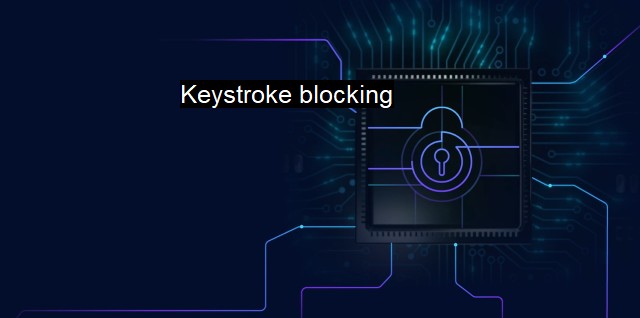What is Keystroke blocking?
Understanding Keystroke Blocking: Vital Protection Against Keyloggers
Keystroke blocking, also referred to as keylogging prevention, is a critical feature in the realm of cybersecurity and antivirus software. From a technical perspective, this mechanism focuses on safeguarding sensitive information from being covertly recorded by keyloggers - malicious programs designed to capture user's keystrokes.To comprehend the complete context, it is essential to first understand the concept of keyloggers. These are a particular type of surveillance technology, often deployed with a criminal purpose. They silently operate in the background, monitoring keyboard inputs to capture confidential data such as security passwords, private conversations, credit card numbers, social security numbers, and other personal information. The covert nature of keyloggers allows them to operate undetected without alerting the victims that their activities are being recorded making them a significant threat to both personal and corporate cyber privacy.
A common misbelief is that antivirus software and firewalls alone are sufficient to counteract keyloggers. they primarily focus on detecting and eliminating known traditional viruses and malware, while purpose-built, sophisticated keyloggers remain undetected and continue to wreak havoc in the background.
This crucial gap in normal defense mechanisms opens the vista for a formidable tool - ‘Keystroke blocking.’ It is a more refined safety measure specifically designed to combat keyloggers by disrupting their primary function: recording user's keyboard inputs.
Keystroke blocking operates by detecting and obstructing software that tries to intercept keystrokes between when a key is pressed and when the corresponding signal is sent to the specific application. It creates a firewall around your typing data, ensuring vital credentials and sensitive text cannot be logged by widespread keylogging software.
Another essential aspect of keystroke blocking dwells in its seamless integration with cryptographic algorithms to encrypt user input straight from the keyboard almost in real time. This essentially means that even if a keylogger manages to bypass and capture keystrokes, it would only record encrypted text – heavily coded information useless for cybercriminals.
Implementing keystroke blocking has become an industry standard, with many leading antivirus programs embedding it as part of their protection suites. Some even offer a dedicated 'virtual keyboard' feature, where all text entries get encrypted, further minimizing the risk posed by keyloggers.
The evolving landscape of cybersecurity keeps pushing the boundaries of what's needed in safeguarding our virtual life. With our increasing reliance on the digital realm for almost everything from shopping, banking, entertainment to communication, cybersecurity has transformed from a backstage science into a daily life necessity, and keystroke blocking is undeniably one of its pivotal components.
The advantages of keystroke blocking aren't just confined to personal safety. Protecting a business's valuable digital assets, customer databases, proprietary secrets, and maintaining its reputation, are also considerable stakes that organizations must consider – which is perhaps why businesses make considerable investments in robust cybersecurity measures, including keystroke blocking technologies.
But, like most defenses, it is important to remember that keystroke blocking should not be the only line of defense. An efficient cybersecurity system is all-encompassing and multidimensional including firewalls, antivirus software, secure networks, data backup, and users’ cybersecurity awareness.
Given that cyber threats are evolving and becoming increasingly sophisticated, the role of keystroke blocking will continue to remain at the heart of cybersecurity. It is a tool designed to protect confidential user information, thwart cyber threats intentions, and instill an enhanced sense of cyber safety in a rapidly digitizing world.

Keystroke blocking FAQs
What is keystroke blocking?
Keystroke blocking is a technique used to prevent hackers and cybercriminals from stealing sensitive information by blocking the recording of keystrokes on a computer keyboard.How does keystroke blocking work?
Keystroke blocking works by intercepting the keyboard input and blocking it from being recorded by keyloggers or other types of malware. This is typically done using specialized software or hardware designed specifically for this purpose.Why is keystroke blocking important in cybersecurity?
Keystroke blocking is important in cybersecurity because it can prevent hackers from stealing sensitive information, such as passwords, credit card numbers, and other confidential data. By blocking keystrokes, it becomes much more difficult for cybercriminals to gain unauthorized access to a computer system or network.What are some common types of keystroke blocking software?
There are a variety of keystroke blocking software programs available, including anti-keylogging software, keystroke encryption software, and virtual keyboards. Some popular examples include Zemana AntiLogger, KeyScrambler, and On-Screen Keyboard.| | A | | | B | | | C | | | D | | | E | | | F | | | G | | | H | | | I | | | J | | | K | | | L | | | M | |
| | N | | | O | | | P | | | Q | | | R | | | S | | | T | | | U | | | V | | | W | | | X | | | Y | | | Z | |
| | 1 | | | 2 | | | 3 | | | 4 | | | 7 | | | 8 | | |||||||